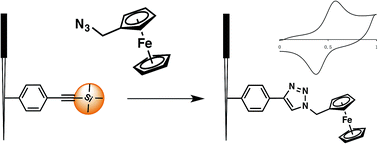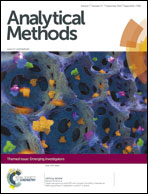A density-controlled scaffolding strategy for covalent functionalization of carbon-fiber microelectrodes†
Abstract
Trace metal detection is of great importance in environmental and biological systems. It is crucial to develop a portable and sensitive device that can determine levels of trace metals in real time. Recently, we described a method for ultrafast and sensitive detection of Cu(II) and Pb(II) in aqueous environmental samples using fast scan cyclic voltammetry (FSCV) at carbon-fiber microelectrodes (CFMs). However, the application of this technique to more complex samples is limited by analytical selectivity. In this paper, we describe a scaffolding strategy for covalent modification of CFMs as a platform for creating selective adsorption sites. We create a monolayer of acetylene-terminated scaffolds on CFMs through the electrochemical reduction of alkynyl aryl diazonium salts bearing sterically differentiated silyl groups, which control the density of the scaffolds. Desilylation reveals the alkyne for further functionalization via Cu(I)-catalyzed azide-alkyne cycloaddition (CuAAC). As a proof of principle, we optimized the conditions for azidomethyl ferrocene to be grafted with the alkynes. All the surface variations of CFMs are electrochemically verified. This innovative strategy provides the groundwork for a broadly applicable method to generate analyte-selective CFMs. The generalized approach offers the potential to attach azide-appended recognition groups to different electrodes in a high throughput manner. This technology will ultimately allow real-time ultra-selective FSCV analysis of metals in complex ecological and biological systems.

- This article is part of the themed collection: Emerging Investigators

 Please wait while we load your content...
Please wait while we load your content...